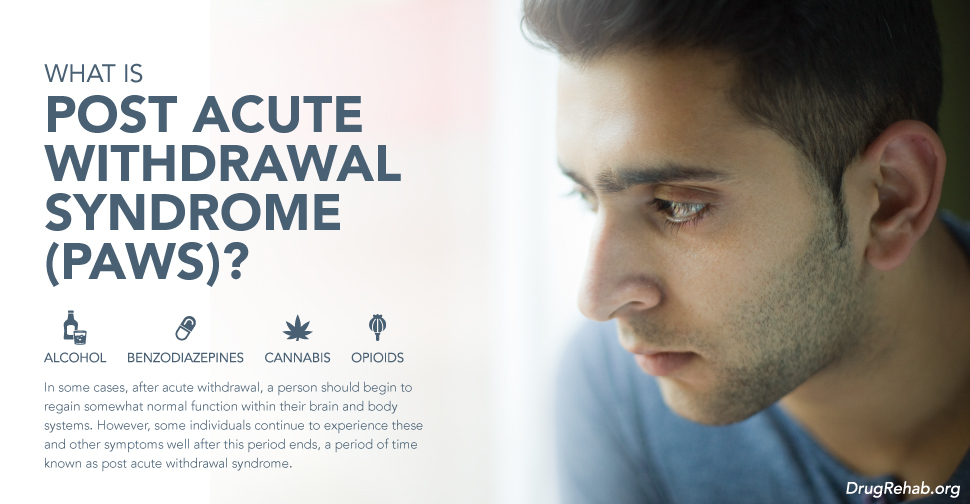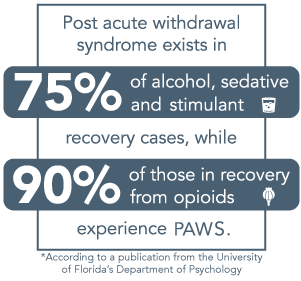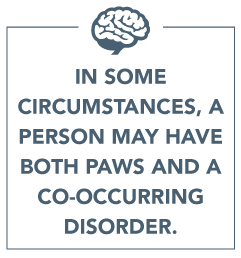
Known under a variety of other names as well, including chronic withdrawal, persistent post use symptoms, protracted abstinence, and, as referred to by the Substance Abuse and Mental Health Services Administration (SAMHSA), protracted withdrawal, post acute withdrawal syndrome (PAWS) encompasses a variety of potentially debilitating symptoms that persist after the period of acute withdrawal ceases. Understanding these symptoms is key towards seeking treatment and preventing relapse.
The Difference Between Acute Withdrawal And Post Acute Withdrawal Syndrome
Why does withdrawal happen? Drugs, whether they be alcohol, an abused prescription medication, or an illicit drug, exert a profound effect on a person’s state of being, including complex changes to important chemical systems within the brain. A person’s brain essentially begins to depend on the presence of these substances in order to function on a somewhat normal level. When these substances are suddenly absent, should a person abruptly stop use, the brain experiences a disruption as it struggles to function without the presence of the drug. This disruption is what causes acute withdrawal symptoms to manifest.

In some cases, after acute withdrawal (AW)—more commonly known simply as withdrawal—wanes, a person should begin to regain somewhat normal function within their brain and body systems. However, some individuals continue to experience these and other symptoms well after this period ends, a period of time known as post acute withdrawal syndrome. This syndrome most commonly affects those users of alcohol, opioids, benzodiazepines, antidepressants, antipsychotics, and other psychoactive drugs, though it may impact those who were addicted to other drugs of abuse as well. To better understand when PAWS may begin, SAMHSA offers the following time frames for acute withdrawal:
- Alcohol: five to seven days
- Benzodiazepines: one to four weeks; three to five weeks with tapering (i.e., reducing dosage gradually)
- Cannabis: five days
- Nicotine: two to four weeks
- Opioids: four to ten days (methadone withdrawal may last 14–21 days)
- Stimulants, including amphetamines, methamphetamine and cocaine: one to two weeks
In greater depth, SAMHSA defines PAWS as “the presence of substance-specific signs and symptoms common to acute withdrawal but persisting beyond the generally expected acute withdrawal timeframes… A broader definition of protracted withdrawal…includes the experiencing of the above symptoms and of non-substance-specific signs and symptoms that persist, evolve, or appear well past the expected timeframe for acute withdrawal.”
The Importance Of Understanding PAWS
The unfortunate truth is that many individuals who suffer from addiction don’t realize that this syndrome exists. Too often, their care providers may fail to mention the existence of it, whether it be because they don’t want to overwhelm the patient or because they dismiss the possibility. This may be in part due to the fact that, as SAMHSA writes, despite numerous clinical and personal reports of this syndrome, the Diagnostic and Statistical Manual of Mental Disorders does not recognize this syndrome within its publications, due to a lack of substantial research. Despite this, experience and evidence show that this is a very real and in some cases, disabling, condition.
Without knowledge of PAWS, should a person begin experiencing this syndrome, they may think that something else is wrong and begin imaging the possibility of more severe circumstances, creating an anxious state which could incite a desire to relapse. In addition, should a person not understand the possibility of PAWS, they will not know how or where to properly seek treatment.
 Like acute withdrawal, this collection of symptoms may push a person towards thoughts of returning to drug or alcohol use, in an attempt to squash the symptoms. Because of this, it is extremely important that a person, and their family members, be aware of PAWS and its symptoms, should it arise, as it is far more prevalent than you may think. The reality is, according to a publication from the University of Florida’s Department of Psychology, post acute withdrawal syndrome exists in 75 percent of alcohol, sedative and stimulant recovery cases, while 90 percent of those in recovery from opioids experience it.
Like acute withdrawal, this collection of symptoms may push a person towards thoughts of returning to drug or alcohol use, in an attempt to squash the symptoms. Because of this, it is extremely important that a person, and their family members, be aware of PAWS and its symptoms, should it arise, as it is far more prevalent than you may think. The reality is, according to a publication from the University of Florida’s Department of Psychology, post acute withdrawal syndrome exists in 75 percent of alcohol, sedative and stimulant recovery cases, while 90 percent of those in recovery from opioids experience it.
How Might A Person Experience PAWS?
Like acute withdrawal, the symptoms vary according to the drug of abuse, and may also differ person to person due to their specific circumstances and physiology. As a guideline, however, SAMHSA offers general symptoms that may occur within this syndrome; they may include:
- Alcohol or drug cravings
- Irritability
- Anxiety
- Presence of a dysphoria state or depression
- Trouble sleeping
- Decreased ability to feel pleasure (anhedonia)
- Decreased libido (interest in sex)
- A reduction in short-term memory
- Chronic and lasting fatigue
- Struggling to concentrate
- Difficulty focusing on tasks
- Impaired decision-making skills
- Reduced control of executive functions
- Physical problems, especially pain, that may not be attributed to a specific cause
One symptom that often appears creates specific worries in terms of relapse. A Huffington Post article elaborates, noting “addicts experience increased impulsivity. Studies have shown that first, addicts continue to make more mistakes than non-addicts when trying to learn how to do things differently, and second, they tend to continue to put less value in future, or distant, rewards.” Beyond this, each drug may create specific concerns. We’ve outlined some of the most reported symptoms below, for three of the drugs that most commonly exhibit PAWS:
Alcohol — An article, “Complications of Alcohol Withdrawal,” notes that protracted withdrawal syndrome (PWS) may cause “symptoms associated with AW that persist beyond their typical time course. These symptoms include tremor; sleep disruption; anxiety; depressive symptoms; and increased breathing rate, body temperature, blood pressure, and pulse. Other symptoms of PWS appear to oppose symptoms of AW. These symptoms of PWS include decreased energy, lassitude, and decreased overall metabolism.”
Benzodiazepines — Research published in the Journal of Substance Abuse Treatment asserts that symptoms may “include anxiety, which may partly result from a learning deficit imposed by the drugs, and a variety of sensory and motor neurological symptoms.” In addition, the American Family Physician notes that a person may have depression and “physical symptoms related to gastrointestinal, neurologic and musculoskeletal effects may occur.” They continue to say that these effects may continue despite a person being tapered from the drug, due possibly to “chronic neuroadaptation” (from the drug of abuse.)

Opioids — ScienceDaily reports that while no physical symptoms of withdrawal were present after four weeks, a lack of sociability and “despair behavior” or depressive-like symptoms arose at this time; also included were decreased levels of energy, disturbed sleep, and anhedonia. These adverse effects are theorized to be due to serotonin dysfunction resulting from drug use.
How Long Might A Person Experience PAWS?
Symptoms of PAWS may last weeks, months, or even years, but as SAMHSA reports, due to the lack of research on the subject, they are not able to offer definitive time frames for this syndrome. Despite this, they do offer some findings on the apparent length of PAWS for certain drugs of abuse, noting the following observed durations:
- Alcohol: Two years or more; sleep disturbances have been observed one to three years after cessation of use.
- Benzodiazepines: A person may initially have no symptoms, however, “Fluctuating protracted withdrawal symptoms may last for months but gradually subside with prolonged abstinence.”
- Cocaine: Certain symptoms were alleviated after four weeks, however, problems regarding impulse control were still present at this time.
- Marijuana: Some symptoms presided for 45 days
- Methamphetamine: No specific time was listed, only that symptoms “persist well into recovery.”
- Opioids: Weeks or months
Regardless of the duration, in order for a person combat PAWS, they must both treat and learn to accept the symptoms.
How To Cope With Post Acute Withdrawal Syndrome
If you or a loved one are overcome with post acute withdrawal syndrome, you may feel very confused and overwhelmed. After such a long journey through drug abuse, addiction, and treatment, it can be very intimidating to face yet another trial, however, there are certain things that you can do to make this period easier.
 When confronted with symptoms of PAWS, your physician or other treatment provider will take several steps to ascertain the situation, to ensure an accurate diagnosis and full treatment. Post acute withdrawal syndrome shares a variety of symptoms with other conditions, including various co-occurring disorders. For this reason, your care provider should assess, and reassess as necessary, for any accompanying disorders such as depression. In some circumstances, a person may have both PAWS and a co-occurring disorder. Addressing treatment needs of the dual diagnosis condition will help a person to more effectively recover and help to prevent relapse. At this time, they will also likely address any sleep problems, while ruling out other medical conditions.
When confronted with symptoms of PAWS, your physician or other treatment provider will take several steps to ascertain the situation, to ensure an accurate diagnosis and full treatment. Post acute withdrawal syndrome shares a variety of symptoms with other conditions, including various co-occurring disorders. For this reason, your care provider should assess, and reassess as necessary, for any accompanying disorders such as depression. In some circumstances, a person may have both PAWS and a co-occurring disorder. Addressing treatment needs of the dual diagnosis condition will help a person to more effectively recover and help to prevent relapse. At this time, they will also likely address any sleep problems, while ruling out other medical conditions.
The following are ways to help alleviate symptoms of PAWS:
Focus on your accomplishments — In a depressed state it can be easy to focus on the negatives. Try to dwell on your positive accomplishments and the fact that you’ve beat your addiction.
Stay active and involved — Maintaining relationships and taking part in activities that bring you pleasure or fulfillment can help maintain optimism during this time, while also providing avenues of support.
Keep balanced — After a life overrun by the negativity of addiction, it can be easy to overdo it by trying to make up for lost time. Take care not to overwhelm yourself—yoga and meditation can help provide balance.
Maintain a healthy lifestyle — Good nutrition, hydration, exercise, and self-care are just as critical within recovery as they were during treatment, and will help your body more readily combat PAWS.
Get regular and good sleep — Good sleep is the backbone of a healthy lifestyle. Strive to get solid sleep, maintaining a regular sleep schedule, while also limiting caffeine intake.
Medication — Certain medications may help you in this time. The Huffington Post suggests that naltrexone may work for alcohol, SSRIs for concerns of depression, and offers that research has shown flumazenil to help in instances related to benzodiazepines. Also, SAMHSA suggests acamprosate for concerns relating to alcohol and methadone or buprenorphine replacement treatment for opioid-related PAWS. Lastly, ScienceDaily details finds on a study done on mice previously dependent on morphine; researchers found that the antidepressant fluoxetine helped to alleviate some PAWS symptoms.
Join a support group — Support groups can be crucial during recovery, especially during PAWS. They will provide you with access to the insight of active listeners who may even share some of your experiences, plus you may learn valuable coping skills.
Therapy or counseling — These elements don’t have to end when treatment ends. An addiction changes you in many ways, and recovery can be difficult. Having a trained ear and a person who can direct you in nurturing and developing new coping skills and positive behaviors is a critical asset during this time; cognitive behavioral therapy has been shown to be helpful.
Maintain medical support — It can be easy to break contact with your care providers after you gain sobriety. Stay in touch with your doctor—it’s important for them to monitor your symptoms so that they can adjust treatments and rule out any other conditions.
Recovering from post acute withdrawal syndrome may not be easy, however, it is possible. Adopting these helpful techniques and lifestyle choices can help to make this time more bearable, while also lowering your risk of withdrawal. Remember: stay focused on your ultimate goal—sobriety—don’t let your hard work fall to the wayside.
Let Us Help You Every Step Of The Way
If you’re experiencing worries related to drug or alcohol abuse, addiction, or recovery, we can help you. Drugrehab.org can offer you, or your loved one, insight and direction at every stage—from your initial concerns, to an intervention, finding treatment, recovery struggles, and aftercare support. Don’t burden yourself contending with this, or any other concern on your own.
Contact us now. Our caring and expert staff can offer you the information and support to make your journey easier and more successful.
Sources
National Institute of Alcohol Abuse and Alcoholism — Complications of Alcohol WithdrawalUniversity of Florida — Post Acute Withdrawal
Huffington Post — The Condition Many Recovering Addicts And Alcoholics Don’t Know About


